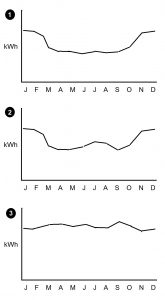This article concerns a retail chain in the UK whose stores are a mix of gas-heated and all-electric buildings, any of which could also be using air conditioning to some extent. Their analysts had the task of defining expected-consumption formulae based on historical consumption and degree-day data. The question was what driving factors they should choose: heating degree days, cooling degree days, or both?
For any store with a gas supply, the answer was reasonably obvious: we could expect gas consumption to depend on heating degree days. Furthermore, electricity in those cases was likely either to be driven by cooling degree days or to be weather-insensitive.
For all-electric stores in general the picture is less clear but the likelihood had to be that heating was the main driver in these cases. This was based on the fact that they were more likely than not to behave like their gas-heated counterparts. So my advice was to treat heating degree days as the primary factor driving week-by-week variation in consumption. After that the only question to answer was whether there was any cooling influence, and that can be answered quickly by looking at the consumption profile through the year. Three scenarios are likely:
1. Higher consumption in winter only. This suggests there is no cooling influence;
2. Higher consumption in winter and summer than in spring and autumn. This clearly indicates a cooling load;
3. Broadly constant consumption all year. This also implies a cooling load.
Why does scenario 3, which shows no seasonal changes, imply the presence of cooling load? Precisely because higher winter consumption is not evident. These buildings must in fact be using heating, but they must also have a seasonal demand for cooling which overlaps the heating season, and adding the two together creates the flat profile.
